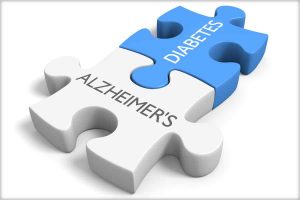
Most people’s first thoughts are that there is no connection between Alzheimer’s disease and type II diabetes. Years ago that may have been true, but research today proves otherwise. In fact, people with type II diabetes are more likely to develop Alzheimer’s, and vice versa. More than 30 million people in the United States have diabetes – about 1 in 10 people. Between 90% and 95% of people with diabetes have type II diabetes. About 5.8 million people, of all ages, in the United States have Alzheimer’s. Roughly 1 in 10 people over the age of 65 has this disease. Alzheimer’s disease is the sixth-leading cause of death in the United States.
What is Alzheimer’s Disease?
Alzheimer’s Disease (AD) is a type of dementia that effects memory, thinking, and behavior. AD usually occurs in old age, most people being over 65, but it can occur in younger people (early-onset Alzheimer’s). It is a progressive disease where symptoms become worse over time. This disease is only diagnosable post-mortem (after death).
What is going on in the brain?
Though it is unknown exactly how AD starts, scientists do know two major abnormal structures that play a role in the pathology of the disease. The first are the presence of beta-amyloid plaques. These plaques are build-ups of the protein fragment, beta-amyloid. The second indicator is the presence of neurofibrillary tangles. These tangles are twisted fibers of the tau protein.
What is Type II Diabetes?
Type II diabetes (T2D) occurs when cells in the body, including in the brain, do not respond normally to insulin. Insulin is a hormone secreted by the pancreas to help regulate glucose (blood sugar) levels. Cells need glucose for energy. Normally, cells willingly take up glucose with the help of insulin. In T2D, cells don’t respond to the insulin, therefore not taking up glucose. This is called insulin resistance. Since glucose doesn’t enter the cells, the pancreas secretes more and more insulin until it eventually can’t keep up. Why T2D occurs is unknown but there are some risk factors including being overweight, fat distribution, inactivity, age, etc.
How are they connected?
- https://www.alz.org/alzheimers-dementia/facts-figures#targetText=An%20estimated%205.8%20million%20Americans,who%20have%20younger%2Donset%20Alzheimer’s.
- https://www.cdc.gov/diabetes/basics/type2.html
- https://www.mayoclinic.org/diseases-conditions/type-2-diabetes/symptoms-causes/syc-20351193
- https://www.alz.org/alzheimers-dementia/what-is-alzheimers